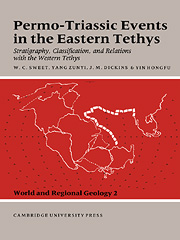 Permo-Triassic Events in the Eastern Tethys
Permo-Triassic Events in the Eastern Tethys Book contents
- Frontmatter
- Contents
- List of contributors
- Preface
- Acknowledgments
- 1 Permo-Triassic events in the eastern Tethys – an overview
- 2 Permo-Triassic boundary relations in South China
- 3 Permo-Triassic boundary of the Indian subcontinent and its intercontinental correlation
- 4 Permo-Triassic boundary on the Indian peninsula
- 5 The Permo-Triassic boundary in the southern and eastern USSR and its international correlation
- 6 Classification and correlation of nonmarine Permo-Triassic boundary in China
- 7 Permian and Triassic events in the continental domains of Mediterranean Europe
- 8 The Permo-Triassic boundary in the Southern Alps (Italy) and in adjacent Periadratic regions
- 9 Permo-Triassic brachiopod successions and events in South China
- 10 Conodont sequences in the Upper Permian and Lower Triassic of South China and the nature of conodont faunal changes at the systemic boundary
- 11 A conodont-based high-resolution biostratigraphy for the Permo-Triassic boundary interval
- 12 The palynofloral succession and palynological events in the Permo-Triassic boundary interval in Israel
- 13 The effects of volcanism on the Permo-Triassic mass extinction in South China
- 14 Geochemical constraints on the Permo-Triassic boundary event in South China
- 15 Permo-Triassic orogenic, paleoclimatic, and eustatic events and their implications for biotic alteration
- 16 Permo-Triassic boundary in Australia and New Zealand
- Index
5 - The Permo-Triassic boundary in the southern and eastern USSR and its international correlation
Published online by Cambridge University Press: 12 October 2009
- Frontmatter
- Contents
- List of contributors
- Preface
- Acknowledgments
- 1 Permo-Triassic events in the eastern Tethys – an overview
- 2 Permo-Triassic boundary relations in South China
- 3 Permo-Triassic boundary of the Indian subcontinent and its intercontinental correlation
- 4 Permo-Triassic boundary on the Indian peninsula
- 5 The Permo-Triassic boundary in the southern and eastern USSR and its international correlation
- 6 Classification and correlation of nonmarine Permo-Triassic boundary in China
- 7 Permian and Triassic events in the continental domains of Mediterranean Europe
- 8 The Permo-Triassic boundary in the Southern Alps (Italy) and in adjacent Periadratic regions
- 9 Permo-Triassic brachiopod successions and events in South China
- 10 Conodont sequences in the Upper Permian and Lower Triassic of South China and the nature of conodont faunal changes at the systemic boundary
- 11 A conodont-based high-resolution biostratigraphy for the Permo-Triassic boundary interval
- 12 The palynofloral succession and palynological events in the Permo-Triassic boundary interval in Israel
- 13 The effects of volcanism on the Permo-Triassic mass extinction in South China
- 14 Geochemical constraints on the Permo-Triassic boundary event in South China
- 15 Permo-Triassic orogenic, paleoclimatic, and eustatic events and their implications for biotic alteration
- 16 Permo-Triassic boundary in Australia and New Zealand
- Index
Summary
Introduction
Transcaucasia and Primorye are regions in which problems of Permian and Triassic biostratigraphy were studied long ago. The first description of Late Permian invertebrates from Transcaucasia was made by Abich (1878) who considered them to be Early Carboniferous. After finding some fossils in his collection that were later described by Stoyanow (1910) as Paratirolites, Mojsisovics (1879) erroneously correlated the appropriate Transcaucasian sediments with the Lower Triassic Tirolites beds in the Alps. After the discovery of the Otoceras beds in the Himalaya (Griesbach, 1880) new possibilities appeared for correlation of the Permo-Triassic boundary beds in Transcaucasia.
Griesbach (1880) considered the Otoceras beds to be earliest Triassic. Later he began to think that they might be intermediate in age between Permian and Triassic. The ammonoids described by Abich and later named Araxoceras, Prototoceras, and Vescotoceras by Spath (1930) and Ruzhencev (1959, 1962), were considered by Griesbach to be close to, or identical with Otoceras. However, on the basis of suture-line data, Mojsisovics (1892) determined ‘ Otoceras’ from Transcaucasia to be more primitive than Otoceras from the Himalayas. In Mojsisovics' opinion, the Transcaucasian forms seemed to be Permian and the Himalayan forms Triassic. Later this idea came to be generally accepted, but it was also discovered that the Transcaucasian rocks (Dzhulfian Stage) with otoceratids lie below Dorashamian sediments (Rostovcev & Azaryan, 1974), which form the uppermost part of the Permian. In southeast China the Changxing Formation occupies this position (Chao, 1965).
Permian ammonoids are not diverse in Primorye. The first Permian ammonoid (Daubichites) was discovered in South Primorye in 1961 (Popov, 1963). Then, some Late Permian ammonoids were described by Ruzhencev (1976), Pavlov, and Zakharov (Zakharov & Pavlov, 1986a,b).
- Type
- Chapter
- Information
- Permo-Triassic Events in the Eastern TethysStratigraphy Classification and Relations with the Western Tethys, pp. 46 - 55Publisher: Cambridge University PressPrint publication year: 1992
- 9
- Cited by


